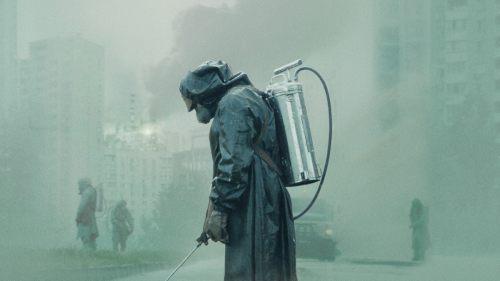How THE CHINA SYNDROME Brought Down The Nuclear Power Industry
When we think about nuclear power, we tend to think about disasters. Real life has given us plenty of reason to do so: between Three Mile Island, Chernobyl, and Fukushima, three major global powers have each seen their nuclear industries fall subject to catastrophe. People died; economies crashed; whole sections of Earth were rendered uninhabitable. Hell, Chernobyl arguably ended the entire Soviet Union.
Entertainment, too, has played a significant role in creating this image of nuclear power. Dozens of movies, TV miniseries, and documentaries over the years have played off and magnified real-life fears, often drawing a direct connection between the “peaceful atom” and its destructive wartime counterpart. One of the first, and most influential, was James Bridges’ 1979 atomic energy thriller The China Syndrome.
“The China Syndrome” is a colloquial term for a very real threat in the event of a nuclear accident. It refers to a reactor accident wherein reactivity becomes so supercritical that operators cannot control it. The fuel gets so hot, it melts its mounting channels, control rods, and even exterior housing, burning through concrete and steel to seep unstoppably downwards - in fanciful terms, all the way to China (hence the name). This actually happened, to a degree, at Chernobyl: the reactor transformed into hundreds of tons of corium lava, eating through multiple basement levels and nearly breaching the building’s foundations before it cooled sufficiently to stop melting concrete. The danger, as with any China Syndrome situation, was that the fuel would reach groundwater, poisoning the land or creating a steam explosion that would blast radioactive material across an enormous area.
Curiously, there is no China Syndrome in The China Syndrome. Based primarily on a 1970 accident at the Dresden Nuclear Power Station in Illinois, the film follows reporter Kimberly Wells (Jane Fonda) and cameraman Richard Adams (Michael Douglas) after they witness an accident while reporting at a California nuclear power plant. The accident seems minor, but it provokes shift supervisor Jack Godell (Jack Lemmon) to probe further than the official investigation is willing to, learning that the plant came perilously close to disaster. In the process, he discovers critical safety violations in the reactor’s construction and, fearing a meltdown, takes the plant hostage with the reporters in tow, publicly demanding its decommissioning. No disaster occurs, but the threat looms over the entire film.
Bridges’ film doesn’t lay the blame at the foot of the technology - which, in an ideal world, would provide plentiful and accident-free energy to millions. It’s people, and institutions, that get the stick. From inspectors falsifying records to finish their job quickly, to managers reluctant to order costly repair work, to executives covering it all up to score new contracts, the nuclear industry is presented as criminally negligent at all levels. It’s even depicted as outright malicious - not entirely without cause, given foul-play theories over the death of nuclear union activist Karen Silkwood - to the extent that the company would murder multiple people to maintain its reputation.
The China Syndrome was incredibly successful. It played in competition at the Cannes Film Festival, where Lemmon won Best Actor; got nominated for four Oscars; won a WGA Award and two BAFTAs (for Fonda and Lemmon); and earned ten times its budget at the box office (for an equivalent of $185 million in today’s dollars). So accurate and believable was the film, it sparked skepticism and outrage about the safety of nuclear power plants, amongst the press and public alike - aided in no small part by Fonda’s status as an activist. Could energy companies ever really keep nuclear plants safe if their bottom line was...their bottom line?
Predictably, the nuclear industry had a fiery reaction. Westinghouse executive John Taylor described the film as “an overall character assassination of an entire industry.” Nuclear experts generally agreed that the film’s specific events were highly improbable (if not entirely impossible), but also that an inherent clash exists between earning corporate profits and spending the money required to keep reactors safe. The industry may have been correct to debate the film's finer technical points or melodramatic ending, but it’s hard to argue that unchecked capitalism doesn't encourage corner-cutting.
On that note, it's worth noting, that The China Syndrome’s institutional failure is near-identical to that which contributed to the Chernobyl disaster. Both saw powerful organisations covering up disastrous mistakes made in the name of cost-efficiency, but they come from opposite ends of the ideological spectrum. One comes from American capitalism, where making money and gaining power comes first and safety regulations are a costly hassle. The other comes from Soviet communism, where saving money and maintaining power came first and safety regulations were a costly hassle. Personal and institutional selfishness knows no political boundaries, and both all-powerful states and all-powerful corporations are prone to malfeasance.
All the industry’s rebuttal ultimately proved ill-advised, of course, as less than two weeks after the film’s release, a reactor underwent a partial meltdown at the Three Mile Island Nuclear Generating Station. Still the most serious nuclear accident in US history, the accident caused no immediate deaths, but the radiation leakage may have contributed to cancers, and the fourteen years of cleanup cost a billion dollars. More importantly, it caused opinion to solidify around the The China Syndrome’s thesis: that the nuclear energy industry could not be trusted with nuclear energy. The accident was so similar to that of The China Syndrome - caused by a stuck valve and a misleading control-room indicator - that conspiracy theorists believed it was a publicity stunt by the studio to promote the movie.
The China Syndrome was still on people’s minds the better part of a decade later, and half a world away. When Chernobyl’s Reactor 4 exploded, and its nuclear fuel mysteriously vanished from view, preventing the China Syndrome (or in this case, the Chile Syndrome) was at the top of the priority list. The phenomenon is alluded to in HBO’s recent series, but what isn’t mentioned is that the film was specifically cited by the Kurchatov Institute's Evgeny Velikhov, who having seen it, considered the meltdown risk much greater than his professional rival, show protagonist Valery Legasov. It really speaks to the film’s cultural impact that not only was the film still being discussed years later - it was being discussed by government officials in the Soviet Union.
Nuclear power has been on the decline since The China Syndrome helped sway the public’s view on the subject - a decline that became all the steeper after Chernobyl. Only recently, with more sophisticated reactor designs, has nuclear had a small resurgence. The debate still rages, however. Is it possible to run a truly safe nuclear power plant? Is there a company in the world that will accept whatever costs are necessary to do so? And was the panic focused in the right place, given that fossil-fuel power generation has caused far more deaths and contributed greatly to a global environmental crisis? Single-event disasters are more frightening than disasters that play out across decades, but they’re both destructive.
It’s fascinating to think what public opinion on nuclear power would look like had The China Syndrome not shone a spotlight on it. Would Three Mile Island have had the same significance in the public eye? Would the subsequent string of anti-nuclear films have been made? Would nuclear power have expanded more than it did, and would that have resulted in more accidents? Pop culture has a profound effect on public sentiment - just ask Soviet propagandists. The history of the past century, in a sense, is the history of pop culture, and vice versa. What will the next China Syndrome be?



